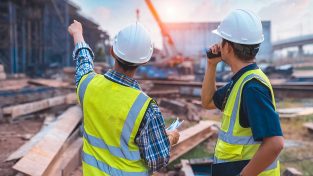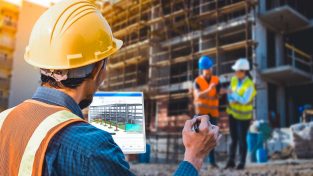The Fourth Industrial Revolution has brought about the advent of Digital Construction – improving construction operations and processes with digital solutions. This new movement takes many forms, such as 3D digital modelling of entire construction sites and visualising end-to-end construction project workflows. In this episode, we speak with Michael James.
Brian: The fourth industrial revolution has brought about the advent of digital construction, improving construction operations of processes with digital solutions. This new movement takes many forms, such as 3D digital modeling of entire construction sites and visualizing end-to-end construction project workflows.
Welcome to HxGN Radio. My name is Brian and today we have Michael James, MEP solutions manager for U.S.-Canada at Leica Geosystems.
Michael James: Hey. How you doing?
Brian: Thank you for joining us.
Michael James: Yeah. Appreciate it. Thank you.
Brian: So you’re going to be discussing digital construction.
Michael James: Sure.
Brian: But first of all, tell us a little bit about what you do at Leica.
Michael James: Yeah, absolutely. So at Leica, I’m responsible for in the building construction segment, mechanical, electrical, plumbing, MEP. In the MEP group, we are bringing to market our 3D scanning solutions and our total station solutions from iCON and its associated software. And really what we’re doing is we’re trying to create the workflow from office to field and field to office, and trying to help us be more productive and help companies be more productive. So yeah.
Brian: All right. So what is digital construction?
Michael James: Digital construction is basically construction in the virtual world and that’s software based and that’s field based and software side. Most people know it by BIM, building information modeling, and companies are taking these models and doing coordination and virtually kind of planning the process, planning the project and kind of sending that information to the field.
Where Geosystems and Hexagon come in is where information that comes to the field through our iCON and Total Station solutions. So we can take in that data from the models, these virtual models and digitally lay out those systems, whether it’s piping or structural or concrete in the field and so it’s kind of like a digital workflow to the field. In addition to the fieldwork, we are also utilizing 3D scanning. So when we’re working in existing conditions or in new projects and we need to capture the real-life environment to come back to the digital world for coordination or BIM, we’re using 3D scanning.
So at Geosystems, we have some of the most fantastic scanning products and that’s what’s really helping us kind of take the real world, make it digital, take the digital world and bring it out to the real world.
Brian: Very nice.
Michael James: Yes.
Brian: So now you mentioned Hexagon’s involvement. How are they contributing to the new world of construction as well?
Michael James: Yes, fantastic products for one. We make some of the best products in the world and software included. Some of the software we’re bringing to the market is really helping these companies in building construction be more productive and we call it … There’s three aspects that we really look at in building construction. How do we make labor more productive? How do we do less waste in the project? How we reduce waste and always in construction it’s always about schedule. So how do we split up the schedule? How do we get things done faster to do more work? And the Hexagon solutions are really helping drive that.
Brian: Good. Good to hear. That’s always important too because schedules can always…
Michael James: Yeah, there’s never enough time. Yeah. Everything needs to be done quick.
Brian: Exactly. Walk us through what digital construction might look like.
Michael James: Yeah, so what digital construction looks like is from the building construction standpoint is basically anytime a building construction company, whether it’s a general contractor, a trade company, like a mechanical contractor or electrical firm gets involved in construction, the digital construction always starts with software, design plans, 3D models, coordination and how that information is produced and then delivered. I mean, by delivered, whether it’s through fabrication, through delivery of systems and equipment to costing, to scheduling, all how we deliver digital information to the field for installation.
Brian: Okay.
Michael James: And what a lot of the solutions that we currently have that really help in drive that delivery approach. So that’s really what it is.
Brian: Okay. Now you were touching on the digital world with the real world, talking about that a little bit. Can you give one or even a few examples of how and where you’ve seen construction professionals implementing these solutions in the real world? So they’re taking it digitally. They’re doing that, but they’re actually implementing it.
Michael James: Yeah. I’ll give you an example. This revolves around our iCON line of products.
Brian: Okay.
Michael James: Which is our Total Stations, our robotic layout instruments and a couple of case examples that customers are. I’ll say building construction companies are using the technology is when they come into the field, you can build this perfect digital model that everything’s coordinated. All systems work. They all fit and when that information is translated to the field, construction’s always not perfect. We’re all human. We build things. They’re not to the millimeter accuracy that. They may be in that model and with iCON, no, we’re being able to load that digital solution, those models and bring it out to the field and lay it out and put it in the correct positions, systems and the piping and the structure all in the right location.
But what else it does is helps identify issues. So on a large coordination project or project where there’s multiple trades involved, one company may be using traditional methods of manual layout and they’re using tape measurers and lasers and so they’re measuring in one method.
There might be another company using maybe an external consultant, maybe a traditional surveying firm and they’re measuring in a different way, maybe off of a state plane coordinate or some other form, some other different base point. Then maybe there’s an iCON, a customer with an iCON solution measuring with our solutions off of a different measurement technique. What this all does is causes a little bit of conflict because we’re all measuring off of different points of interest and really what the iCON solutions do help us kind of shoot, identify as built and kind of identify those inconsistencies ahead of time — and allows us all to get on the same page. For the guys that are maybe doing tape measure, we could do some layout and put some measurements, some base points for them so we can have them start measuring off the same baselines, if that makes sense.
Brian: Yes, it does.
Michael James: Yes.
Brian: That’s great.
Michael James: Yes.
Brian: That is true. There’s so many different …
Michael James: Techniques.
Brian: Exactly and who knows which one’s doing the best at this moment or where’s the consistency aspect and so that is important.
Michael James: Yes.
Brian: Okay. So going along with that, and then you mentioned the fact that you’re trying to keep the schedules faster or more consistent as well. You talked about eliminating waste as best as possible. What does all of this mean, the digital solutions and all that for the construction industry’s future?
Michael James: For the future, obviously, the construction industry is doing phenomenal. I mean, there’s tons and tons of work going on right now and one of the things is labor is still a shortage. There’s not enough people to do the work, especially in the U.S. And what the technology really is helping us now and in the future is really be more productive, do more with less and companies are really I think starting to realize that. If they can do a lot more with less, they can actually do more work because they’d be more productive with our technology.
Brian: Yeah. What about the quality and consistency in that scenario? Is that going to improve?
Michael James: Yes, and that gets a little into the cost standpoint. Companies are being more productive. They’re more efficient with their labor because of the technology and material waste. So they’re actually gonna make more money. They’re going to do more work, make more money, be more productive.
Brian: Love it.
Michael James: Yes. It’s great. It’s great.
Brian: That’s very good. It’s good to see the solutions coming out and really helping the industry and just in general. So any last thoughts?
Michael James: Last thoughts are I guess I would say, even with this understanding and getting companies to step into the, I say jump into the pool and actually adopt this technology is we’re still, I think, kind of in the beginning stages of that. And, kind of last thoughts are if there’s a company out there that’s really on that edge, we do have a lot of flexible solutions, a Hexagon to be able to allow them to onboard easily, learn the technology, train and help them be more productive and hope they can jump in and try the technology.
Brian: Yes, definitely. All right, well thank you very much for the information, Michael. Appreciate it.
Michael James: Yes, appreciate it. Thank you.
Brian: All right. For more information on today’s topic, visit leica-geosystems.com and to learn more and listen to additional episodes, head over to HxGNspotlight.com and thank you very much for joining us here on HxGN Radio.
















